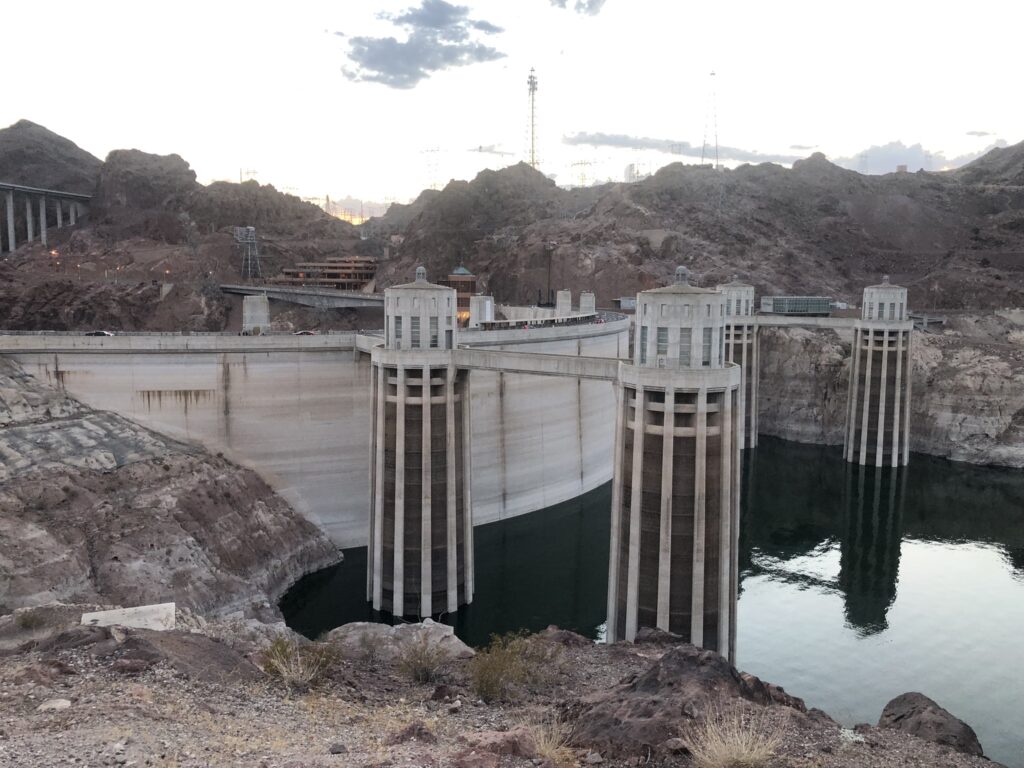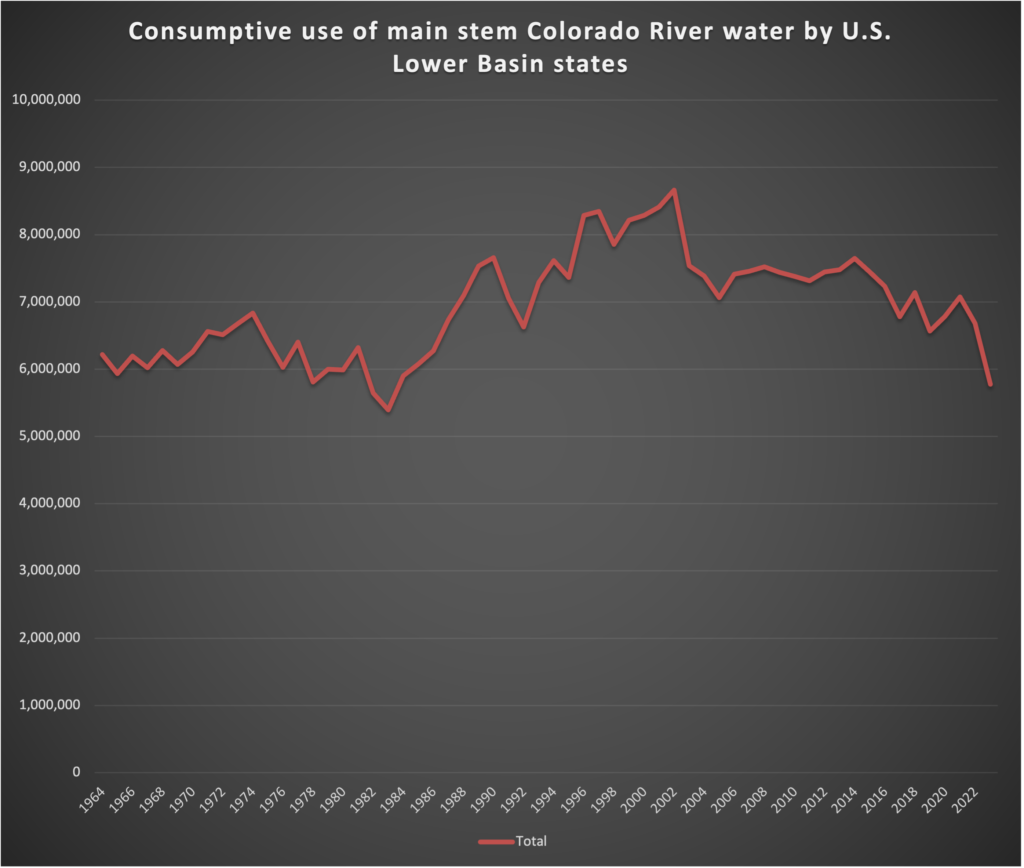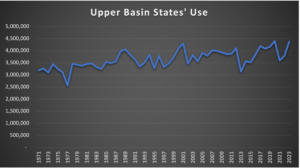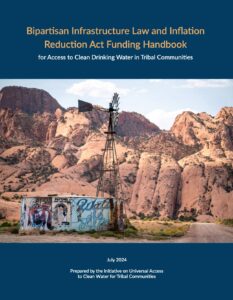How did we do in the continuing effort to recover reservoir storage? How much reservoir storage accumulated from this year’s snowpack, and how does that accumulation compare to other years?
In Summary:
Total basin-wide reservoir storage is an appropriate metric to describe the status of the regional water supply and its year-to-year changes. Reclamation provides data on the storage contents of 46 reservoirs in the basin that are primarily managed by the Bureau of Reclamation but also by municipal water agencies and water conservancy districts. Whether destined for within-basin use or for trans-basin diversion, the total amount of water in these reservoirs is the carryover storage available to sustain use during dry times.
Accumulation of storage in those reservoirs occurred between mid-April and early July 2024, and basin-wide storage increased by 2.5 million acre feet. This amount is only 30% of the increase in storage that occurred during the same period in 2023. Nevertheless, basin-wide reservoir storage increased by 300,000 af when the summer peak of 2024 is compared with the summer peak of 2023, because consumptive uses and losses in the intervening time between the two runoff years was only 2.2 million acre feet. Despite the modest runoff of 2024, water managers were able to increase reservoir storage, because they had done such a good job of limiting consumptive uses following the 2023 runoff season.
Today, 62% of the total basin-wide storage is in Lake Mead and Lake Powell. The combined contents of these two largest reservoirs in the United States peaked on 8 July at 18.5 million af. Most of 2024’s snowmelt runoff was stored in Lake Powell, and storage in Lake Mead declined during spring and early summer 2024. Now that the runoff season has ended, some of the contents of Lake Powell will be gradually transferred to Lake Mead.
The Details:
On 6 July, storage in the Colorado River basin peaked for the year at 30.0 million acre feet (af), approximately 50% of capacity of the reservoir system1 (Fig. 1). The combined contents of Lake Mead and Lake Powell peaked on 8 July at 18.5 million af, approximately 37% of the capacity of those two reservoirs. The last time total basin reservoir storage was as much as this was in early January 2021, and the combined storage of Lake Mead and Lake Powell had last been at its present volume in very late April 2021. Thus, reservoir storage has not yet recovered to the average conditions between 2005 and 2020.

Figure 1. Graph showing reservoir storage in the Colorado River watershed between 1 January 1999 and 15 July 2024.
The season of water accumulation, when inflow to reservoirs exceeds outflow, that began in mid-April has now ended. How did we do in the continuing effort to recover reservoir storage? How much reservoir storage accumulated from this year’s snowpack, and how does that accumulation compare to other years?
The snowpack of the Upper Basin peaked on 3 April at 16.8 in of snow water equivalent (SWE)2. For comparison, the median peak SWE for the past 30 years, as computed by the Natural Resource Conservation Service, was 16.0 in., so 2024 was a pretty good year. Nevertheless, 2024 was not nearly as good a year as 2023 when the peak SWE was 23.9 in. Preliminary estimates of natural flow at Lees Ferry for Water Year 2024 are that this year’s natural flow3 will be 12.1 million af, although that estimate may change slightly by the end of the water year.
The relation between peak estimated SWE in the Upper Basin and natural flow at Lees Ferry has a reasonably good correlation for data from 2000 and the years of the 21st century (Fig. 2). There is year-to-year variation in this relation caused by springtime weather that affects the rate of melting and the amount of sublimation. Variation is also caused by the intensity of the summer North American monsoon that augments the natural flow but is unrelated to snowmelt. Estimated natural runoff in 2024 was well predicted by the general relation.

Figure 2. Graph showing the relation between peak annual snow water equivalent for the Upper Colorado River basin and natural flow at Lees Ferry, estimated by Reclamation. The solid line is an exponential relation fit to these data.4
The amount of water added to reservoir storage is very well predicted by the natural flow at Lees Ferry (Fig. 3), and this relation shows that much more of the natural runoff is captured by reservoirs in wet years than in dry years. In 2024, approximately 20% of the estimated natural flow was stored, consistent with comparable years (2010, 2014, 2015, and 2016) (Fig. 3). A higher proportion of the natural runoff was stored in the wet years of 2005, 2011, 2019, and 2023, when more than 40% of the natural runoff was captured in reservoirs. More than 30% of the natural runoff was stored in 2008, 2009, and 2017.

Figure 3. Graph showing increase in basin-wide reservoir storage as a function of natural flow at Lees Ferry. The solid line is linear relation fit to these data5.
The combined contents of Lake Mead and Lake Powell peaked on 8 July, but storage in each reservoir followed very different trajectories (Fig. 4). Lake Powell, which is upstream from Lake Mead, captured the inflowing snowmelt runoff and increased in storage by 2.2 million af between mid-April and early July while Lake Mead lost approximately 900,000 af. Now that the inflow season has ended, storage will gradually decline in Lake Powell and increase in Lake Mead.

Figure 4. Graph showing the distribution of reservoir storage in different parts of the Colorado River basin between 1 January 2021 and 15 July 2024.
The storage gains resulting from the 2024 runoff compensated for the consumption of reservoir storage that had occurred after the 2023 runoff season (Fig. 5). This year’s peak of 30.0 million af is slightly more than the peak storage in summer 2023 that was 29.7 million af. This small increase in storage occurred despite a modest 2024 runoff season, because the basin’s water managers had done a good job in conserving the gains of last year (see blog post of 21 May 2024). Only 2.2 million af was consumed or lost following the 2023 runoff season, and the gain of 2.5 million af in 2024 exceeded the preceding loss. Thus, basin-wide storage is ever so slightly better than last year, because we used so little water last year. We now begin a 9-month period when the job in front of us is to continue to reduce consumptive uses and losses until the onset of the 2025 snowmelt season. Let’s not lose focus. We’re all in this together.

Figure 5. Graph showing changes in reservoir storage between 1 January 2023 and 15 July 2024.
1. These data are for 46 reservoirs whose daily storage contents are reported by Reclamation at:
https://www.usbr.gov/uc/water/hydrodata/reservoir_data/site_map.html. The data summarized here are through 15 July.
2. Natural Resources Conservation Service. Snow water equivalent data accessed at:
https://nwcc-apps.sc.egov.usda.gov/awdb/basin-plots/POR/WTEQ/assocHUC2/14_Upper_Colorado_Region.html.
3. Bureau of Reclamation. Natural flow data accessed at:
https://www.usbr.gov/lc/region/g4000/NaturalFlow/provisional.html. Lees Ferry data were released on 22 April and are provisional and based on the April 24-month study. This estimate will be revised in August.
4. This relation is y = 4,048,600 * e
(0.06632 x) , where
y is the annual natural flow at Lees Ferry for the water year, in acre feet, and
x is the peak snow water equivalent of the year, in inches. The R
2 of this relation is 0.73.
5. This relation is y = -6,484,000 + 0.75833 X , where
X is the annual natural flow at Lees Ferry for the water year, in acre feet, and
y is the increase in basin-wide reservoir storage that occurred during the snowmelt season typically between mid-April and mid-July . The R
2 of this relation is 0.92. Data used to calculate this relation do not include 2002 and 2012 when basin-wide storage decreased during the snowmelt season.
We encourage the use of these figures in your own work with appropriate credit (Jack Schmidt, Center for Colorado River Studies). Please
contact us if higher resolution images are required.












